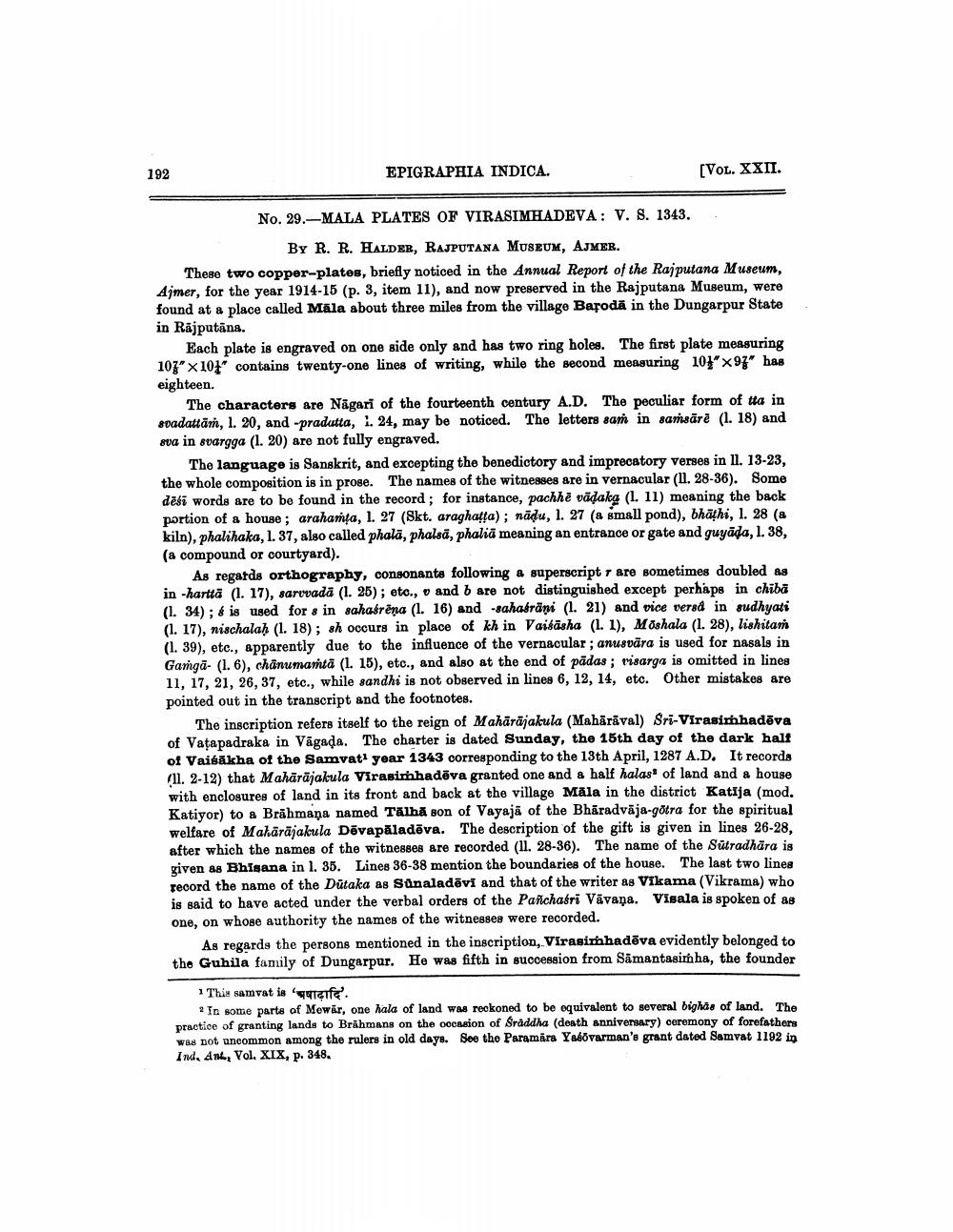________________
192
EPIGRAPHIA INDICA.
(VOL. XXII.
No. 29.-MALA PLATES OF VIRASIMHADEVA: V. S. 1343.
By R. R. HALDER, RAJPUTANA MUSEUM, AJMER. These two copper-plates, briefly noticed in the Annual Report of the Rajputana Museum, Ajmer, for the year 1914-15 (p. 3, item 11), and now preserved in the Rajputana Museum, were found at a place called Mala about three miles from the village Baroda in the Dungarpur State in Räjputāna.
Each plate is engraved on one side only and has two ring holes. The first plate measuring 107" x 101" contains twenty-one lines of writing, while the second measuring 101" x 97" has eighteen.
The characters are Nägari of the fourteenth century A.D. The peculiar form of tta in svadattām, 1. 20, and -pradutta, 1. 24, may be noticed. The letters sam in samsāre (1. 18) and sva in svargga (1. 20) are not fully engraved.
The language is Sanskrit, and excepting the benedictory and imprecatory verses in 11. 13-23, the whole composition is in prose. The names of the witnesses are in vernacular (11. 28-36). Some dësi words are to be found in the record; for instance, pachhë vādaka (1. 11) meaning the back portion of a house; araharta, 1. 27 (Skt. araghata); nādu, 1. 27 (a small pond), bhäthi, 1. 28 (a kiln), phalihaka, 1. 37, also called phalā, phalsā, phalia meaning an entrance or gate and guyāda, 1. 38, (a compound or courtyard).
As regards orthography, consonants following a superscript sre sometimes doubled as in -hartta (1. 17), sarvvada (1. 25); etc., u and are not distinguished except perhaps in chiba (1. 34); & is used for 8 in sahasrena (1. 16) and -sahafrāni (1. 21) and vice versd in sudhyati (1. 17), nischalah (1. 18); sh occurs in place of kh in Vaisāsha (1. 1), Moshala (1. 28), lishitan (1. 39), etc., apparently due to the influence of the vernacular; anusvära is used for nasals in Gangā- (1. 6), chānumată (1. 15), etc., and also at the end of pādas; risarga is omitted in lines 11, 17, 21, 26, 37, etc., while sandhi is not observed in lines 6, 12, 14, etc. Other mistakes are pointed out in the transcript and the footnotes.
The inscription refers itself to the reign of Mahārājakula (Mahārāval) Sri-Virasimhadēva of Vatapadraka in Vāgada. The charter is dated Sunday, the 15th day of the dark halt of Vaišākha of the Samvatyear 1343 corresponding to the 13th April, 1287 A.D. It records (11. 2-12) that Mahārājakula Virasimhadēva granted one and a half halas. of land and a house with enclosures of land in its front and back at the village Māla in the district Katija (mod. Katiyor) to a Brāhmaṇa named Talhā son of Vayajā of the Bhāradvāja-götra for the spiritual welfare of Mahārājakula Dövapāladēva. The description of the gift is given in lines 26-28, after which the names of the witnesses are recorded (11. 28-36). The name of the Sūtradhāra is given as Bhisana in l. 35. Lines 36-38 mention the boundaries of the house. The last two lines record the name of the Dütaka as Sunaladēvi and that of the writer as Vikama (Vikrama) who is said to have acted under the verbal orders of the Panchasri Vāvana. Visala is spoken of as one, on whose authority the names of the witnesses were recorded.
As regards the persons mentioned in the inscription, Virasimhadēva evidently belonged to the Guhila family of Dungarpur. He was fifth in succession from Samantasimha, the founder
1 This samvat is 'qafe.
2 In some parts of Mewar, one hala of land was reckoned to be equivalent to several bighas of land. The practice of granting lands to Brahmans on the occasion of Sraddha (death anniversary) ceremony of forefathers was not uncommon among the rulers in old days. See the Paramára Yalvarman's grant dated Samvat 1192 in Id, A., Vol. XIX, p. 348,




